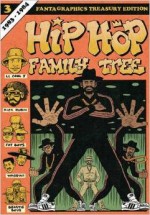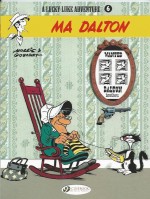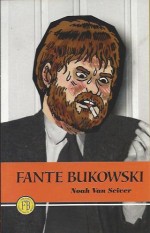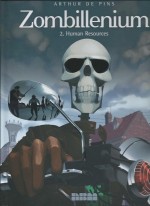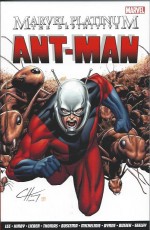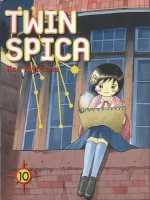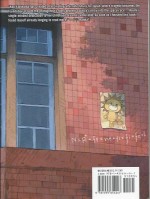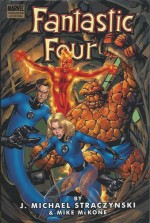
By Keiji Nakazawa (Last Gasp)
ISBN: 978-0-86719-600-9
I first found the Educomics magazine I Saw It! in 1982; initially seduced by a garish cover and the Chester Gould-like illustrations. There was precious little translated manga around then and the magazine was lumped in with the wild, wacky and often salaciously outrageous “Underground Comix†on the racks of my regular comics shop, across the road from Goldsmith’s College from where I had just graduated before starting as tea-boy on iconic Warrior magazine.
I was cocky, big-headed and, I thought, extremely well versed in all aspects of comics but still utterly gobsmacked after I read it…
In England we’ve had educational comics for decades, but this was something completely new to me. There was no tasteful distancing here; just an outraged scream of defiance and a direct plea to make things right. This was history and politics and it was deadly serious, not played for laughs or to make points as British cartooning traditionally did.
Constantly revised and refined by its creator and publishers around the world, I Saw It! became Barefoot Gen, and now the entire epic semi-autobiographical saga has being remastered as an unabridged and uncompromising 10-volume English-language translation by Last Gasp under the auspices of Project Gen, a multinational organisation dedicated to peace and the abolition of nuclear weapons.
Hadashi no Gen was first seen in Japan began in 1973, serialised in ShÅ«kan ShÅnen Jampu (Weekly Boys Jump) following an occasional 1972 series of stand-alone stories in various magazines which included Kuroi Ame ni Utarete (Struck by Black Rain) and Aru Hi Totsuzen, (One Day, Suddenly).
These eventually led Shonen’s editor Tadasu Nagano to commission the 45-page Ore wa Mita (I Saw It) for a Monthly Jump special devoted to autobiographical works. Nagano clearly recognised that the author – an actual survivor of the word’s first atomic atrocity – had much more to say which readers needed to see and commissioned the serial which has grown into this stunning landmark epic.
The tale was always controversial in a country which still often prefers to ignore rather than confront its mistakes and indiscretions and, after 18 months, Hadashi no Gen was removed from Jump, transferred first to Shimin (Citizen), then Bunka HyÅron (Cultural Criticism), and KyÅiku HyÅron (Educational Criticism).
Like his indomitable hero, Keiji Nakazawa never gave up and his persistence led to a first Japanese book collection in 1975, translated by the original Project Gen team into Russian, English and then other languages including Norwegian, French, German, Italian, Portuguese, Swedish, Finnish, Indonesian, Tagalog and Esperanto.
The author at long last completed his story in 1985 and his telling testament of survival has since been adapted into live-action and anime films, operas, musicals and live-action television dramas.
Undoubtedly mirroring Nakazawa’s own creative journey, this penultimate volume shares the moment it all changed for a hardy, forward-looking and indomitable idealist and individualist who finally found a way to express his anger and effectively fight back against the idiocies and injustices of a world which had let Atom bombs fall, and at last challenge those pedagogues and self-seekers who chose to keep the bad old ways alive even after their people suffered the most hideous of consequences…
Possibly the most inspirational volume of Keiji Nakazawa’s graphic masterpiece, Barefoot Gen: Breaking Down Barriers begins following ‘Some Thoughts About Keiji Nakazawa’ by Project Gen Editor Alan Gleason, who has been with the grand design since 1977 – practically from inception – and offers here telling insights and historical perspective. The other end of this monochrome paperback balances the essay with a biography of the author and invaluable data ‘About Project Gen’…
This stunning graphic manifesto resumes with an ancient history lesson as fearful peasants are told their precious rice paddies are to be destroyed by the local military in order to make a road for troop movements. As one bold serf dares to protest and suffers grievously for it, Gen awakes in the communal shack he and his friends cobbled together out of rubble and scavenged debris of Hiroshima. He shares it with other “bomb-orphans†and, until this morning, his last surviving family member.
Now however older brother Koji Nakaoka is moving out to get married, but at least rambunctious Ryuta and quietly stolid Musubi are staying put. The former reform school kids have become super-salesmen, selling dresses made by radiation-scarred outcasts Natsue and Katsuko on Hiroshima’s gradually restored and rebuilt street corners. The long-term goal is typically ambitious: the girls will sew and the boys will sell until they have saved enough money to open their own shop.
Today however Ryuta is in an excitable state. He’s the most devoted follower of the city’s woefully sub-par baseball team the Hiroshima Carp and is sharing his hopes and fears for the new season with any highly amused passer-by he can corral…
By the time the hapless sports fan returns to uncharacteristically gloomy Gen at the shack another crisis has arisen: a horde of military types are besieging the hovel intent on tearing it down to make way for a proposed “Peace Memorial City†and they don’t care that the kids have lived there for years and have nowhere else to go.
Gen and Ryuta’s vigorous, violent and initially successful “Dirty Protest†defence of their home is savage and disgusting but ultimately doomed to failure…
When the little war is finally lost Gen is painfully marked for life and carries another burden of stored anger, but at least ailing Natsue is not present to see the loss of their home. She is in the mountains, completing a ceramic urn to contain her ashes after she dies…
Gen has known her since the earliest aftermath of the bomb: a young dance student he twice saved from her own fatalistic intent, but recently she has been physically failing. Never quite recovering from appendix surgery, she is now convinced her remaining days are few and is preparing for the end…
Forcibly relocated to a tiny riverside shack, the disparate band gather to celebrate surviving another day, but when exhausted Natsue finally joins them and proudly shows off her beautiful funerary urn Gen “accidentally†shatters it. Next morning, increasingly furious Ryuta attacks his best friend for his clumsiness and apparent lack of remorse in upsetting Natsue and learns the true depth of Gen’s compassion. As their brutal clash accidentally envelopes and infuriates a haughty street fortune teller, Gen reveals he acted deliberately to shock Natsue out of her pervasive death-spiral, believing he can keep her alive by sheer anger. Eying the enraged seer screaming at them, he then concocts an even bolder plan to reinvigorate her vanished will to live…
When Ryuta later leads the entire gang past a heavily-bearded prognosticator-for-hire, the oracle predicts long life and a fabulous future for the fatally-depressed girl but can’t resist also having a hilarious pop at her mouthy Carp-loving companion. The session works splendidly however and Natsue agrees to return to hospital for doctors to treat her still unhealed surgical wounds. Sadly not even unflagging optimism and Gen’s guile can fix everything…
In the tragic aftermath fresh horror emerges as two pious gentlemen intrude upon the youngsters’ grief, offering to arrange a splendid funeral for Natsue. Gen however is not fooled and realises they are simply clever “Vultures†working for the Americans…
In occupied Japan news media was absolutely forbidden from discussing or reporting the effects of atom bombs and the populace had no knowledge of exactly what had happened at Hiroshima and Nagasaki. Indeed, amidst the rubble of the destroyed cities, most of the 300,000 terrified, bewildered survivors had no idea what was happening to their bodies – or that they were not unique or even isolated cases – but were consoled by the seemingly-benign and tireless humanitarian efforts of the Atomic Bomb Casualty Commission.
These were officials employed by the US Occupation forces, tasked with acquiring – even often buying – bodies of recently deceased bomb survivors for scientists to examine. The bomb-makers were hungry for information on the after-effects of their hell-weapons and apparently did not see victims as human. They simply dissected bodies, harvested organs and collated facts: always hungry for more data. Gen had dealt with them before, when they stole the fresh corpse of his little sister Kimie…
The ABCC even pay for teams to go into schools to regularly examine the health of children, working to a hidden agenda aided by local Japanese doctors bribed to send everyone they could to the Americans. For each referral they were rewarded with fancy drugs, many sold for profit to the black market. No one with bomb-related symptoms was treated or cured; just tested and catalogued.
Now with the knowledge enflaming him, Gen responds with brutal violence, beating and driving off the Vultures before he and his friends steal Natsue’s body…
She had died on the 6-month anniversary of the beginning of the Korean War just as General Douglas MacArthur (Supreme Commander for the Allied Powers and de facto Emperor of Japan) convinced US President Truman to announce the deployment of atomic weapons for that conflict too. Thankfully, concerted global outcry convinced them to withdraw the threat…
In January 1951, Gen, Ryuta, Musubi and Katsuko are on a pilgrimage to inter their lost friend’s ashes above the city on Mount Hiji, but are thwarted by the discovery that the ABCC have built a vast complex on the once-beautiful site. After displaying their disdain in the approved scatological manner, the weary mourners decide to place the urn Gen worked so long and hard to reconstruct within the Nakaoka family grave, but as they trudge to the cemetery their precious cargo is stolen by a street urchin.
Giving ferocious chase they corner the little thief and administer the customary beating, leading to a confrontation with an old man who would change Gen’s life forever…
At first artist Seiga Amano cannot believe his grandson Tatsuro would stoop so low, but when he realises why the boy has turned to thievery, his proud heart almost breaks…
Eventually everybody calms down and Gen gives the old painter art materials he has stored ever since an old, dying man briefly stayed at their shack, sharing with the grateful painter the knowledge that his own father was also an artist before the bomb. Their riverside conversation inspires a life-changing aspiration within the lad that turns his life to a new path. Gen begs the elder to teach him everything he knows so that he can prove his new, all-consuming mantra “Art Has No Bordersâ€â€¦
The next lucky happenstance occurs when Gen stumbles onto a sign painter producing a cinema poster for a Kurosawa Double Feature. Toro Otsuki boasts he is the greatest exponent of his craft in Hiroshima, a claim brutally backed up by his thuggish assistant Kurosaki who foolishly attacks the loud-mouthed young gawker only to be soundly trounced for his temerity.
Sadly in the melee the painting is wrecked and honourable, guilt-struck Gen swears to make amends to the artist and his sadistic boss Nakao; an unrepentant former-soldier now bullying his way into civilian life…
When Seiga Amano and grandson Tatsuro pass by and see Gen enduring savage abuse in his attempts to atone, another fight begins and Otsuki breaks an arm, compelling Amano to step in and complete the poster. The rapidly-completed masterpiece instantly mollifies the militant Nakao who sees another business opportunity…
The constant stream the Boss provides is the making of Gen who serves as assistant and willing, eager student to Seiga, rapidly learning the basics of a discipline which will change his life.
As spring arrives more change is in the air. General MacArthur is summoned home and older conservative citizens begin to panic as their surrogate Emperor deserts them. Ryuta is typically scathing of the nervous old farts and isn’t there when a band of thugs target Gen, seeking to chop off his arm. The plucky little scrapper quickly ends their threat and knows jealous Kurosaki is behind the scheme, but after taking a measure of vengeance Gen surprises himself by getting to know his enemy and learning the horrific story of the abuse his fellow bomb orphan suffered at the hands of priests who were supposed to be protecting the lost children of Hiroshima…
With a deeper understanding but no real resolution to their stalled conflict, Gen returns to his diligent studies but his peace of mind will soon be shaken by the return of an old enemy…
Militaristic elements of Japan were deftly re-establishing themselves as the city grew again: attempting to whitewash their pasts for the New Japan. When ardent – and genuine – anti-war protestor Gen sees a poster announcing Denjiro Samejima, running for political office, claiming he opposed the war and was a “soldier for Peaceâ€, Gen boils over at the villain’s hypocrisy and reacts with his usual earthy passion…
During the war that wily demagogue was a secret Black Marketeer who denounced Gen’s father – a genuine anti-war dissident – and led a hate-campaign that tormented the entire Nakaoka family. Now the rogue is profiting by stealing and feigning his beloved father’s ideals and dreams, just like so many other criminals who would deny history and the truth in search of self-advancement…
The scathing insights into the sordid character of political opportunists are potent reminders of why society never changes, reminiscent of George Orwell’s polemics, and by seemingly moving slightly off-message Nakazawa actually drives home his points with far greater force. Barefoot Gen is positively Reithian in its ability to Educate, Inform and Entertain and its legacy will be as pervasive and long-lasting…
And yet even at its most bleak and traumatic Keiji Nakazawa’s magnum opus never forgets to be funny, compelling and enjoyably Human. The broad cartoon style of Keiji Nakazawa’s art has often been the subject of heated discussion; the Disney-esque, simplified rendering felt by some to be at odds with the subject matter, and perhaps diluting the impact of the message. I’d like to categorically refute that.
Mister Nakazawa’s style springs from his earliest influence, Osamu Tezuka, Father of Animé and God of Manga who began his career in 1946 and whose works – Shin Takarajima (New Treasure Island), Tetsuwan Atomu (Astro Boy) and so many more – eased some of the grim realities of being a bomb survivor, providing escape, hope and even a career path to the young boy.
As such the clear line, solid black forms and abstracted visual motifs act as tolerable symbols for much of the horror in this parable. The art defuses, but never dilutes, the terrible facts and scenes of the tragedy and its aftermath. The reader has to be brought through the tale to receive the message and for that purpose the drawings are accurate, simplified and effective. The intent is not to repel (and to be honest, even as they are they’re still pretty hard to take) but to inform, to warn.
So now you’ve been warned, buy this series. Better yet, agitate your local library to get a few sets in as well. Barefoot Gen is a world classic and should be available to absolutely everyone…
© 2009 Keiji Nakazawa. All rights reserved.
